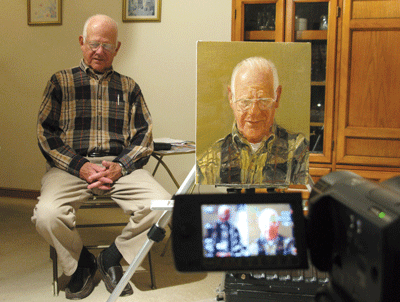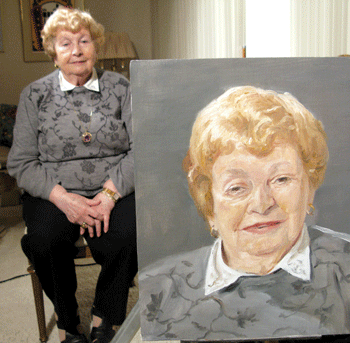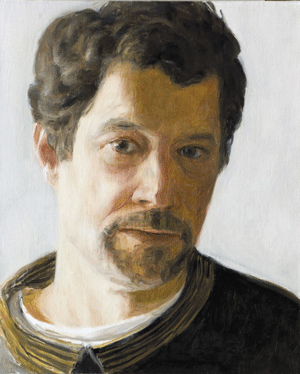A Spanish painter offers local Holocaust survivors a new way to share their experiences
By ERIN ELLIOTT BRYAN / Community News Editor
Spanish artist Felix de la Concha was in the Twin Cities recently as a guest of the Center for Holocaust and Genocide Studies (CHGS) at the University of Minnesota, as part of his project of interviewing and painting Holocaust survivors.
The project, titled Portraits with Conversation, consists of a two-hour session in which de la Concha paints a portrait of a survivor while they offer oral testimony about their personal experience.
During his time in Minnesota, de la Concha met with eight local survivors — Gus Gutman, Max and Edith Goodman, Walter Schwarz, Lucy Smith, Fred Amram, Victor Vital and Herb Fantle — and also spoke at the university. His visit was part of the CHGS’ interest in interdisciplinary approaches to studying and teaching the Holocaust, and was co-hosted by the Department of Spanish and Portuguese Studies.
The paintings and recordings of the sessions were donated to the University of Minnesota and the CHGS, and will be used for future multimedia exhibitions and educational tools.
“It’s a very original way of speaking about the Holocaust, of conveying the story of the Holocaust,” said Dr. Alejandro Baer, the Stephen Feinstein Chair and director of the CHGS. “I think [de la Concha] showed a way that nobody had thought of yet, of how to present the stories of the survivors. And at the same time, he’s making a statement — he’s talking about testimony, about the act of testimony. It’s about the present, about how we value stories.”
Baer said the project fits well with CGHS’ mission and its commitment to artistic representations of the Holocaust.
“We’re at the forefront on the issue of artistic representations of the Holocaust, artistic responses. That’s what our center is very well known for, the Virtual Museum and all the artwork that we have,” Baer said. “This is a matter that the center has dealt with since the very beginning, when Steve Feinstein was here. He had a great passion for art of the Holocaust and art on the Holocaust.”

As for de la Concha, a native of Léon, Spain, who now splits his time between Iowa City, Iowa, and Madrid, he always had an interest in the stories of Holocaust survivors. And he recognized that time was running out to record their testimony.
“We are the last generation to have this opportunity to have direct contact with people that have witnessed this,” de la Concha told the AJW. “Even when we know so much of history, from books, from documentaries and movies, about the Holocaust, I never had the privilege to have the direct contact and this human approach… There is always the feeling, emotion, expression, and that is what I wanted to capture as well.”
For the most part, de la Concha is the only other person in the room with his subject, which he says creates a sense of intimacy. During the session, he sets up a video camera to record the oral testimony, as well as the evolution of his painting. De la Concha lets his subjects talk and tries not to interfere — even if they move around or look away.
“Sometimes, even the sitter, when they see the portrait, they say ‘Oh, I look worried.’ I try to explain to them that it’s because they’re talking about something intense, so they have an expression where they may look worried. It has to be seen in this context,” de la Concha said. “The portrait is all together with the process, and the video and the audio, so it’s to be seen in the context of what it is about, it’s not just about the portrait by itself.”

De la Concha started this project several years ago and has painted more than 30 Holocaust survivors. He said each of the stories and experiences is different, as well as the ways in which the subjects choose to express them; some, for example, are not chronological.
“That doesn’t matter, it’s the moments [they] remember and the way they are going to tell me the stories,” de la Concha said. “It’s not something academic, it’s nothing about just getting more data.”
And de la Concha has a broad definition of “survivor.” For him, it’s someone who survived the Holocaust, whether in a concentration camp or as a hidden child or by escaping to another country.
“They belonged to the community where they have all these stories and relatives, and it has marked all their lives in some way,” de la Concha said. “That’s also important to know, including the second generation and how they have been influenced by the Holocaust. That’s also something important to record.”
De la Concha admits that his project can be very intense and emotionally exhausting. But he says he’s learned so much that he would not otherwise be aware — and he wants to share that with his audiences.
“It’s different when you read it than how [survivors] can focus on something. If they start to repeat something, for instance, how they were starving… and they’re emphasizing that and they’re repeating it, how they communicate it makes you realize the level of the experience,” de la Concha said. “The oral testimonies are very important… I learned that this human touch is very interesting, so I learned a lot in that emotional way.”

For Baer, a scholar of Holocaust memory and testimony who has directed the Spanish section of the Shoah Visual Archives project, de la Concha’s work is a very particular method of bearing witness. One local survivor, for example, told Baer that de la Concha had “captured him at the moment he was reflecting on his past.”
“The videos are capturing the story, but his portrait captures the act of bearing witness, of remembering, of presenting the story in the present, of conveying that story today and that’s a very powerful way of communicating,” Baer said, noting that the CHGS was very thankful to the survivors who participated. “Felix de la Concha’s visit has added a new chapter, a new element that has enriched the collection and the discussion about these issues.”
***
For information, visit: chgs.umn.edu.
(American Jewish World, 3.15.13)



















